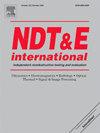Feasibility of passive intermodulation test for detecting corrosion in reinforcing bars
IF 4.1
2区 材料科学
Q1 MATERIALS SCIENCE, CHARACTERIZATION & TESTING
引用次数: 0
Abstract
The passive intermodulation (PIM) test is a nondestructive test utilizing the nonlinear reflections of electromagnetic (EM) waves to identify material deterioration. This study explored the feasibility of the PIM test for detecting corrosion in reinforced concrete (RC) structures. First, the principle of the PIM was explained, and the devised PIM test equipment was described. Subsequently, the PIM test was performed on rebar, plain concrete, and RC specimens with various corrosion degrees. The results indicated that plain concrete generated large PIM signals, attributed to a nonuniform permittivity distribution, whereas the rebar specimens exhibited small or no PIM signals, resulting from relatively linear reflections. The RC specimens exhibited smaller PIM signals than plain concrete, suggesting that the rebar inside the concrete reduced the PIM signals by linearly reflecting a part of EM waves. Rebar corrosion further reduced the PIM signals owing to the scattering of EM waves. Therefore, rebar corrosion can be identified through smaller PIM signals compared with the surrounding region. Furthermore, the effect of rebar contact nonlinearity on the PIM signals was investigated using contacted rebars. The results indicated that corrosion reduced the PIM signals even with the contacted rebars. Therefore, the PIM test is feasible for detecting rebar corrosion.
求助全文
约1分钟内获得全文
求助全文
来源期刊

Ndt & E International
工程技术-材料科学:表征与测试
CiteScore
7.20
自引率
9.50%
发文量
121
审稿时长
55 days
期刊介绍:
NDT&E international publishes peer-reviewed results of original research and development in all categories of the fields of nondestructive testing and evaluation including ultrasonics, electromagnetics, radiography, optical and thermal methods. In addition to traditional NDE topics, the emerging technology area of inspection of civil structures and materials is also emphasized. The journal publishes original papers on research and development of new inspection techniques and methods, as well as on novel and innovative applications of established methods. Papers on NDE sensors and their applications both for inspection and process control, as well as papers describing novel NDE systems for structural health monitoring and their performance in industrial settings are also considered. Other regular features include international news, new equipment and a calendar of forthcoming worldwide meetings. This journal is listed in Current Contents.
 求助内容:
求助内容: 应助结果提醒方式:
应助结果提醒方式:


